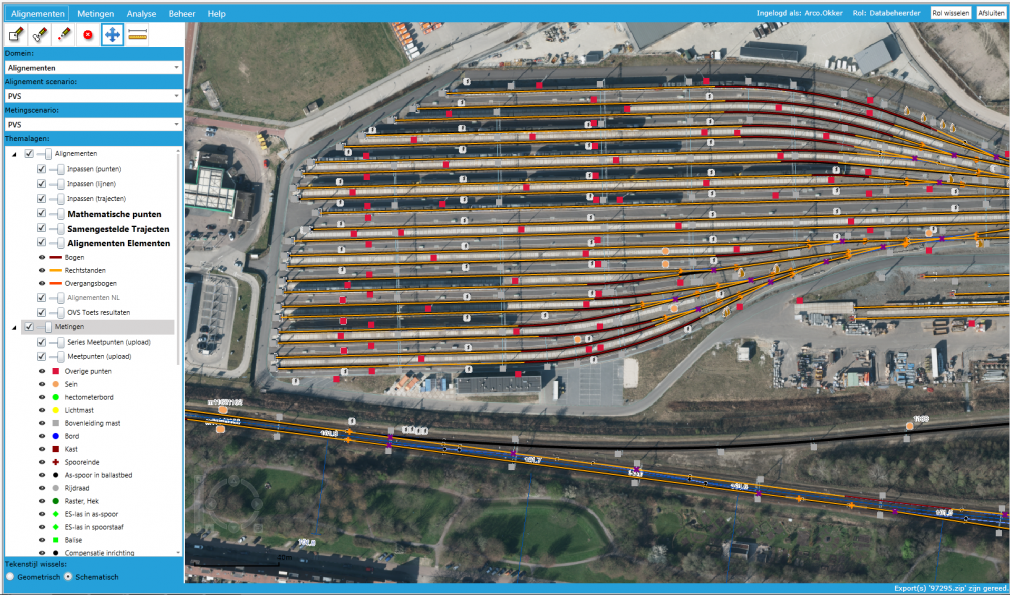All digital infrastructure information in one place with rail data programme
Raymond Soeters ProRail Looking at the details of a broken track object before going onto the track, providing information about the future network to the logistic planning process much earlier, and driving a train through a station before the track has been laid: all of this is possible with the Rail Data programme from the Dutch infrastructure manager ProRail, in which all relevant information about the network is digitalised and all stakeholders can access it with the touch of a button. Programme manager Raymond Soeters will give a presentation about Rail Data at the Intelligent Rail Summit on the 24th of November.

At the beginning of this year, railway infrastructure manager ProRail launched SpoorData, a programme in which all available, up-to-date, correct and clear data about the Dutch railway network is collected and shared by the railway network sector. ProRail started the SpoorData programme as previously available information about track objects sometimes turned out to be incorrect in practice, explains programme manager Raymond Soeters and ITC Manager Lars Vriesendorp from ProRail.
Rail Data
ProRail started the programme in 2014, to ensure that by the end of 2017 all up-to-date and uniform information about the important track objects would be available for in an even higher quality for all the main rail companies involved. Currently, data about track objects is still in the hands of multiple network parties. The intention is that all information will come from one source, to which all partners will have access. Consequently all parties will be using the same information, meaning a level playing field and lower error sensitivity.
“SpoorData consists of multiple projects, which ensure that all parties involved in the railway network can record information about the network and changes to it in the same way, and share this with everyone. Therefore everyone can make use of it directly when carrying out their business operations. Via the website www.spoordata.nl (Dutch) the information will be shared with all relevant parties.”
More reliable track
According to ProRail, SpoorData contributes towards a more reliable track. “For example, by combining high-quality information about a switch with the switch’s current condition, its history of defects and planned and realised maintenance, timely preventative maintenance can be booked in and so breakdowns can be avoided”, explains Soeters. “If a defect occurs, we can fix this more quickly because we have all the relevant information about the switch to hand, such as the breakdown history and the technical instructions.”
SpoorData contains two types of data. The statistical side concerns the configuration data of track objects, such as the location, function and physical characteristics of the switches and electrical separation joints. The dynamic side is the management data for the track objects, including maintenance data, the condition of the track, defects and recording inspections.
Innovative solutions
ProRail is working on the programme to correctly record all new data in one go, making a single round of corrections to all existing infrastructure data. To do so, the network manager is using innovative solutions such as ‘digital inspection’: recording the infrastructural data using an inspection train, and comparing with the underlying databases.
During the correction of information, ProRail is closely examining the way in which information is delivered by the various parties. “We discovered that not all data was entered in the same way, which could sometimes lead to abnormalities,” says Soeters.
One language
In the past, all parties had their own data. Lars Vriesendorp: “We put all data in the same form, so all parties use the same source. We have agreed to use one language, the information model Rail, and we all share information in the same way.”
“In order to promote clarity we have in some cases made datasets smaller and simplified the input of new data. For example, you get an error message if you choose a particular combination. So if you select a wooden sleeper when you are entering a new object, you get an error message because that type is no longer allowed.”
3D world
When maintenance tasks are put out to tender, it is very important that all parties have the same information available, explains Soeters. “There is strong competition among the various maintenance contractors. Therefore it is important that there is a level playing field. If everyone has the same information about the condition of the network, they can all put in a good offer. From now on, the network contractors do not have to go on the track to see the dimensions and the state of the infrastructure.”
Vriesendorp: “Where we ultimately want to get to is a 3D world for the railway network, in accordance with the principles of Building Information Modelling (BIM). All parties will work together on an infrastructure project in a digital 3D project environment and will exchange information, complying with open information norms. For example, one party will design underground infrastructure such as cables and leads, and the other will work on the above-ground design in the same model.”
Shorter lead time
By combining these different worlds, each designer can more quickly see other designs, discuss them, easily elaborate on them, and start their own work sooner. According to ProRail, a design will be realised in fewer iterations, fewer repairs will be needed and projects will have shorter leader times. “What we already done is letting train drivers drive in a 3D world through a tunnel in Delft, before the tunnel was operational. Therefore they could say in advance if the signals were in the right place,” explains Vriesendorp.
Soeters: “We can go forward a bit in time to see what the network will look like in the future. We call this a ‘photo of the future’, where five years before commissioning we add the data about the future infrastructure to the logistic planning process. SpoorData plays a role in this by drawing up a logistic plan and timetable with fewer train-free periods and repair actions.”
Raymond Soeters will give a presentation about Rail Data on day 3 at the Intelligent Rail Summit on the 24th of November.
View the topics of discussion and the speakers for each individual theme:
- Day 1: Wayside Train Monitoring Systems
- Day 2: Rail Infrastructure Measuring & Monitoring
- Day 3: Big Data in Railway Operations
We look forward to welcoming you in Naples between 22 – 24 November for the Intelligent Rail Summit.
